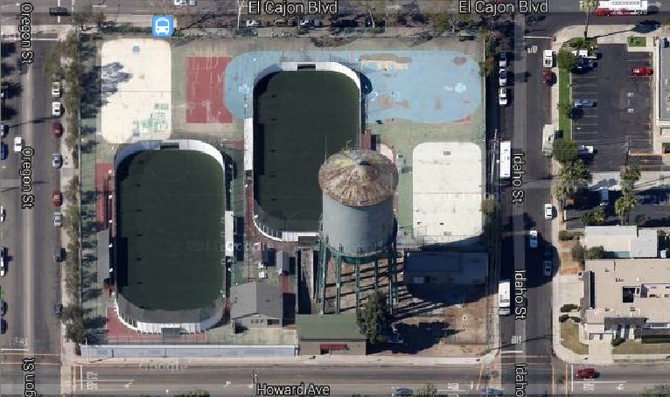 Facebook
Facebook
 X
X
 Instagram
Instagram
 TikTok
TikTok
 Youtube
Youtube

North Park’s big green water tower — officially designated as the University Heights Water Storage and Pumping Station, even though it's located south of El Cajon Boulevard (on Idaho Street, north of Howard Avenue) — has been listed on the National Register of Historic Places, thanks to the efforts of local historian Alexander Bevil.
“The Tin Man,” as Bevil calls it, made the national register earlier this year as part of a historic district that includes a lot of stuff you can't see — the underground pumping station that still serves the once-called “streetcar suburbs,” including City Heights, Normal Heights, and Kensington.
The 127-foot, 5.5-inch tall tower worked from 1924 to 1967 and cost an estimated $69,100 to build — work done by the Pittsburgh-Des Moines Steel Corporation. As the tallest structure in the area, many locals use it as a marker when they give directions.
The reservoir and pumping station beneath were built in 1908, 16 years before the Tin Man, which was finished in 1924 and was billed as the tallest water tower in the world at the time. It held 3.172 million gallons of water in a partially underground tank the size of the block. Back in 1910, the city had already built an above-ground tower and a second reservoir on the south side of Howard, where the city park now stands.
But as the area grew, Bevil explained, city engineers realized that there wasn't enough water pressure to maintain delivery; they looked at running a pipeline from the Chollas Reservoir pumping station but then decided it was more economical to build the tower, which relies on gravity for water pressure.
Over time, the city added chlorination and filtration plants to the two-block area. "The park used to be the location of an 11-million gallon reservoir," Bevil said.
In 1967, the city demolished the reservoir south of Howard Avenue and built a community park in its place, Bevil noted in the meticulously researched application for the national register.
Bevil said he worked on the application part-time for six to eight months. He said he first came across the records when he worked at the city architect's office doing neighborhood surveys.
"Every time I go by it, I'd wonder why it wasn't listed," Bevil said. "It still functions as a water distribution and storage center."
(revised 4:13 p.m., 9/30)


North Park’s big green water tower — officially designated as the University Heights Water Storage and Pumping Station, even though it's located south of El Cajon Boulevard (on Idaho Street, north of Howard Avenue) — has been listed on the National Register of Historic Places, thanks to the efforts of local historian Alexander Bevil.
“The Tin Man,” as Bevil calls it, made the national register earlier this year as part of a historic district that includes a lot of stuff you can't see — the underground pumping station that still serves the once-called “streetcar suburbs,” including City Heights, Normal Heights, and Kensington.
The 127-foot, 5.5-inch tall tower worked from 1924 to 1967 and cost an estimated $69,100 to build — work done by the Pittsburgh-Des Moines Steel Corporation. As the tallest structure in the area, many locals use it as a marker when they give directions.
The reservoir and pumping station beneath were built in 1908, 16 years before the Tin Man, which was finished in 1924 and was billed as the tallest water tower in the world at the time. It held 3.172 million gallons of water in a partially underground tank the size of the block. Back in 1910, the city had already built an above-ground tower and a second reservoir on the south side of Howard, where the city park now stands.
But as the area grew, Bevil explained, city engineers realized that there wasn't enough water pressure to maintain delivery; they looked at running a pipeline from the Chollas Reservoir pumping station but then decided it was more economical to build the tower, which relies on gravity for water pressure.
Over time, the city added chlorination and filtration plants to the two-block area. "The park used to be the location of an 11-million gallon reservoir," Bevil said.
In 1967, the city demolished the reservoir south of Howard Avenue and built a community park in its place, Bevil noted in the meticulously researched application for the national register.
Bevil said he worked on the application part-time for six to eight months. He said he first came across the records when he worked at the city architect's office doing neighborhood surveys.
"Every time I go by it, I'd wonder why it wasn't listed," Bevil said. "It still functions as a water distribution and storage center."
(revised 4:13 p.m., 9/30)
Comments